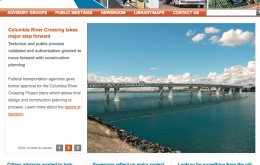U.S. Department of Transportation Secretary Ray LaHood has some explaining to do.
LaHood, who famously stood on a tabletop and thanked bike advocates for their hard work at the 2010 National Bike Summit and later posted on his blog that, “This is the end of favoring motorized transportation at the expense of non-motorized,” has now become an enthusiastic booster of the Columbia River Crossing project — a five-mile long, highway widening mega-project being proposed by the Oregon and Washington departments of transportation.
“… people do want alternatives. They want out of their cars; they want out of congestion; they want to live in livable neighborhoods… This is the end of favoring motorized transportation at the expense of non-motorized.” — Ray LaHood, March 2010>
“We are big, big, huge supporters of the Columbia River Crossing.”
— Ray LaHood, November 2011
Often characterized as only a bridge project (the result of masterful PR work by project consultants who have spent millions on messaging), the CRC would also significantly widen five miles of I-5 as well as beef up and add five new highway interchanges along the way. The project’s main purpose is to make driving an automobile easier, safer and more convenient.

about a bridge, it’s only
about a bridge, it’s only….
(Screenshot from CRC site)
Many critics of the project fear it will induce traffic as well as encourage sprawl in northern Clark County. The project is estimated (by the CRC staff themselves, so it could very well be much more) to cost $3.1 to $3.6 billion dollars, an amount that could suck up much of the region’s transportation funding — at the expense of other projects and needs — for years to come.
Despite the controversy around this project and what many smart people see as significant flaws and risks in moving forward with it — LaHood and the USDOT are eager to see it break ground.
“We are big, big, huge supporters of the Columbia River Crossing,” LaHood told KGW TV last month. “We think it is a classic example of what America has always been known for doing big things.”
I’d put an emphasis on “classic.” He’s right. This is indeed a “classic” project in the sense that it harkens back to the 1950s with its focus on moving as many cars and trucks as possible right through the heart of many (formerly livable) neighborhoods and two major cities.

of a lot more than just
fixing an old bridge.
Today, the USDOT released a major endorsement of the project with approval of the “record of decision.”
Contrast this support of the CRC with LaHood’s proclamations in 2010:
“People want walking paths, biking paths… I’ve been all over America, and where I’ve been in America I’ve been very proud to talk about the fact that people do want alternatives. They want out of their cars; they want out of congestion; they want to live in livable neighborhoods.”
“People across America who value bicycling should have a voice when it comes to transportation planning. This is the end of favoring motorized transportation at the expense of non-motorized.”
I’m one of those people who wants to live in livable neighborhoods. My family and I live just two blocks from I-5 and the CRC’s new mega-highway comes to an end just a few tenths of a mile north of my backyard. I’m worried that the CRC’s please-try-out-the-awesome-new-freeway-we-built-for-you welcome mat will only lead to more traffic in my neighborhood and massive bottlenecks to boot.
As the national bike advocacy community has fallen over themselves in praise of LaHood for his outspoken support of livability and a new way of doing business at the DOT, I’ve held back. Maybe I’ve grown cynical over the years; but while I still feel a tinge of excitement when a powerful person like LaHood says nice things about something I believe in, I’m waiting for action in the face of difficult and politically challenging conditions.
Policy proclamations and rosy rhetoric are easy. Challenging and questioning the merits of a mega-project that has a lot of political power behind it is hard. An era based on that power won’t end easily; but it’s what has to be done and some of us thought LaHood was the one who would do it.
Perhaps LaHood feels like because the CRC includes a light rail line and a wider bikeway it’s all good. But I’m not sure everyone who had faith in him — not to mention the many adoring advocates he spoke to on that that memorable night in D.C. — agree.
—
I’m curious what readers think: Is it possible to support something that is as “motorized transportation” centric as the CRC while still making proclamations about livability and promoting active transportation? Can leaders like LaHood have it both ways?


